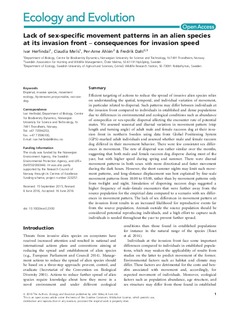| dc.description.abstract | Efficient targeting of actions to reduce the spread of invasive alien species relies on understanding the spatial, temporal, and individual variation of movement, in particular related to dispersal. Such patterns may differ between individuals at the invasion front compared to individuals in established and dense populations due to differences in environmental and ecological conditions such as abundance of conspecifics or sex-specific dispersal affecting the encounter rate of potential mates. We assessed seasonal and diurnal variation in movement pattern (step length and turning angle) of adult male and female raccoon dog at their invasion front in northern Sweden using data from Global Positioning System (GPS)-marked adult individuals and assessed whether male and female raccoon dog differed in their movement behavior. There were few consistent sex differences in movement. The rate of dispersal was rather similar over the months, suggesting that both male and female raccoon dog disperse during most of the year, but with higher speed during spring and summer. There were diurnal movement patterns in both sexes with more directional and faster movement during the dark hours. However, the short summer nights may limit such movement patterns, and long-distance displacement was best explained by fine-scale movement patterns from 18:00 to 05:00, rather than by movement patterns only from twilight and night. Simulation of dispersing raccoon dogs suggested a higher frequency of male–female encounters that were further away from the source population for the empirical data compared to a scenario with sex differences in movement pattern. The lack of sex differences in movement pattern at the invasion front results in an increased likelihood for reproductive events far from the source population. Animals outside the source population should be considered potential reproducing individuals, and a high effort to capture such individuals is needed throughout the year to prevent further spread. | nb_NO |

